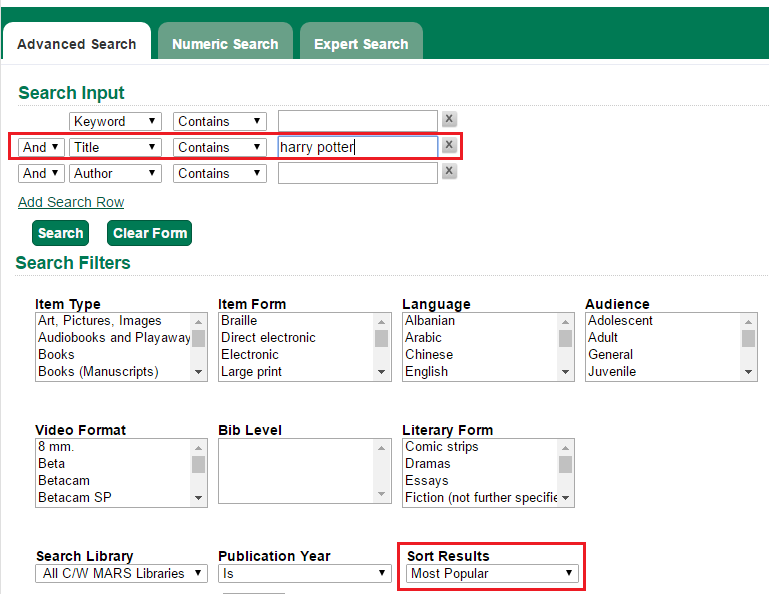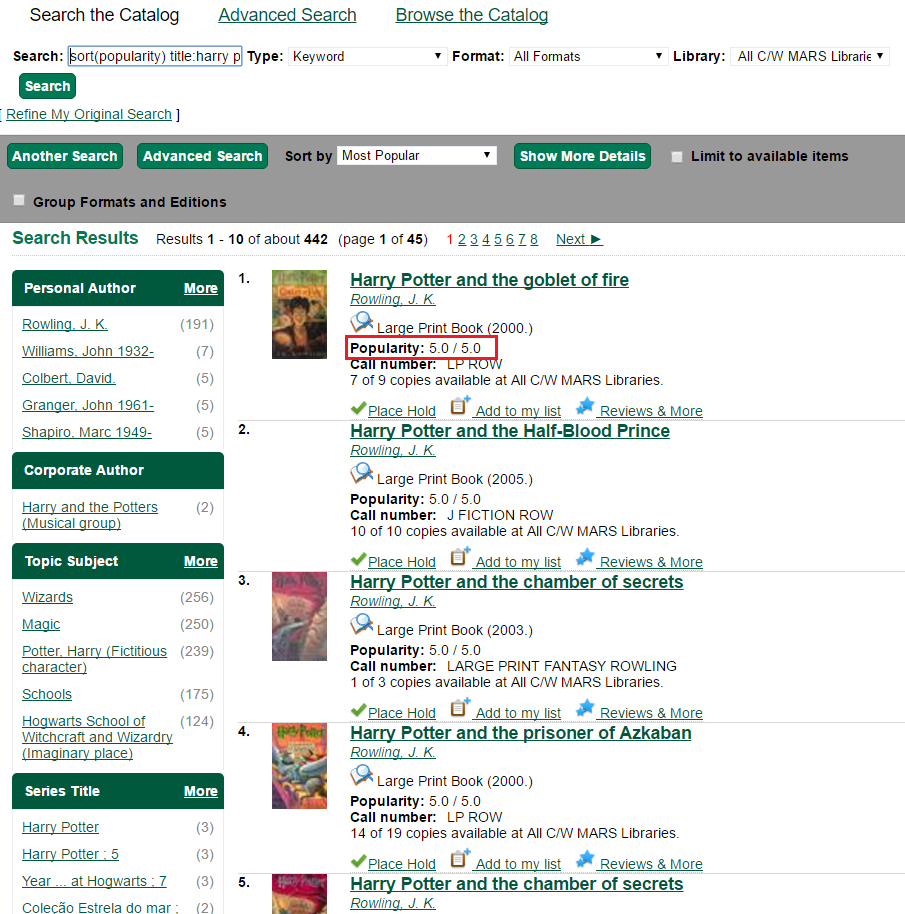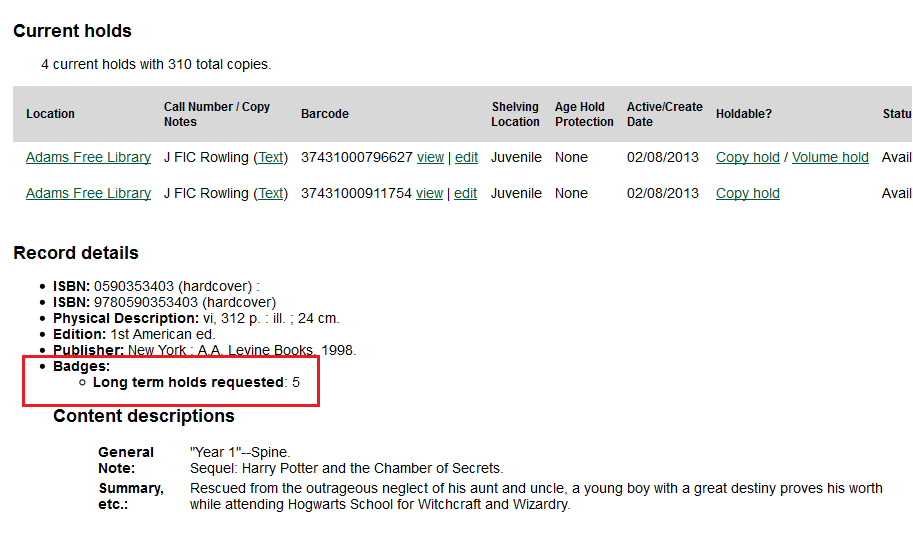Statistical Popularity Badges
Statistical Popularity Badges allow libraries to set popularity parameters that define popularity badges, which bibliographic records can earn if they meet the set criteria. Popularity badges can be based on factors such as circulation and hold activity, bibliographic record age, or material type. The popularity badges that a record earns are used to adjust catalog search results to display more popular titles (as defined by the badges) first. Within the OPAC there are two new sort options called "Most Popular" and "Popularity Adjusted Relevance" which will allow users to sort records based on the popularity assigned by the popularity badges.
Popularity Rating and Calculation
Popularity badge parameters define the criteria a bibliographic record must meet to earn the badge, as well as which bibliographic records are eligible to earn the badge. For example, the popularity parameter "Circulations Over Time" can be configured to create a badge that is applied to bibliographic records for DVDs. The badge can be configured to look at circulations within the last 2 years, but assign more weight or popularity to circulations from the last 6 months.
Multiple popularity badges may be applied to a bibliographic record. For each applicable popularity badge, the record will be rated on a scale of 1-5, where a 5 indicates the most popular. Evergreen will then assign an overall popularity rating to each bibliographic record by averaging all of the popularity badge points earned by the record. The popularity rating is stored with the record and will be used to rank the record within search results when the popularity badge is within the scope of the search. The popularity badges are recalculated on a regular and configurable basis by a cron job. Popularity badges can also be recalculated by an administrator directly on the server.
Creating Popularity Badges
There are two main types of popularity badges: point-in-time popularity (PIT), which looks at the popularity of a record at a specific point in time—such as the number of current circulations or the number of open hold requests; and temporal popularity (TP), which looks at the popularity of a record over a period of time—such as the number of circulations in the past year or the number of hold requests placed in the last six months.
The following popularity badge parameters are available for configuration:
-
Holds Filled Over Time (TP)
-
Holds Requested Over Time (TP)
-
Current Hold Count (PIT)
-
Circulations Over Time (TP)
-
Current Circulation Count (PIT)
-
Out/Total Ratio (PIT)
-
Holds/Total Ratio (PIT)
-
Holds/Holdable Ratio (PIT)
-
Percent of Time Circulating (Takes into account all circulations, not specific period of time)
-
Bibliographic Record Age (days, newer is better) (TP)
-
Publication Age (days, newer is better) (TP)
-
On-line Bib has attributes (PIT)
-
Bib has attributes and copies (PIT)
-
Bib has attributes and copies or URIs (PIT)
-
Bib has attributes (PIT)
To create a new Statistical Popularity Badge:
-
Go to Administration→Local Administration→Statistical Popularity Badges.
-
Click on Actions→Add badge.
-
Fill out the following fields as needed to create the badge:
only Name, Scope, Weight, Recalculation Interval, Importance Interval, and Discard Value Count are required -
Name: Library assigned name for badge. Each name must be unique. The name will show up in the OPAC record display. For example: Most Requested Holds for Books-Last 6 Months. Required field.
-
Description: Further information to provide context to staff about the badge.
-
Scope: Defines the owning organization unit of the badge. Badges will be applied to search result sorting when the Scope is equal to, or an ancestor, of the search location. For example, a branch specific search will include badges where the Scope is the branch, the system, and the consortium. A consortium level search, will include only badges where the Scope is set to the consortium. Item specific badges will apply only to records that have items owned at or below the Scope. Required field.
-
Weight: Can be used to indicate that a particular badge is more important than the other badges that the record might earn. The weight value serves as a multiplier of the badge rating. Required field with a default value of 1.
-
Age Horizon: Indicates the time frame during which events should be included for calculating the badge. For example, a popularity badge for Most Circulated Items in the Past Two Years would have an Age Horizon of '2 years'. The Age Horizon should be entered as a number followed by 'day(s)', 'month(s)', 'year(s)', such as '6 months' or '2 years'. Use with temporal popularity (TP) badges only.
-
Importance Horizon: Used in conjunction with Age Horizon, this allows more recent events to be considered more important than older events. A value of zero means that all events included by the Age Horizon will be considered of equal importance. With an Age Horizon of 2 years, an Importance Horizon of '6 months' means that events, such as checkouts, that occurred within the past 6 months will be considered more important than the circulations that occurred earlier within the Age Horizon.
-
Importance Interval: Can be used to further divide up the timeframe defined by the Importance Horizon. For example, if the Importance Interval is '1 month, Evergreen will combine all of the events within that month for adjustment by the Importance Scale (see below). The Importance Interval should be entered as a number followed by 'day(s)', 'week(s)', 'month(s)', 'year(s)', such as '6 months' or '2 years'. Required field.
-
Importance Scale: The Importance Scale can be used to assign additional importance to events that occurred within the most recent Importance Interval. For example, if the Importance Horizon is '6 months' and the Importance Interval is '1 month', the Importance Scale can be set to '6' to indicate that events that happened within the last month will count 6 times, events that happened 2 months ago will count 5 times, etc. The Importance Scale should be entered as a number followed by 'day(s)', 'week(s)', 'month(s)', 'year(s)', such as '6 months' or '2 years'.
-
Percentile: Can be used to assign a badge to only the records that score above a certain percentile. For example, it can be used indicate that you only want to assign the badge to records in the top 5% of results by setting the field to '95'. To optimize the popularity badges, percentile should be set between 95-99 to assign a badge to the top 5%-1% of records.
-
Attribute Filter: Can be used to assign a badge to records that contain a specific Record Attribute. Currently this field can be configured by running a report (see note below) to obtain the JSON data that identifies the Record Attribute. The JSON data from the report output can be copied and pasted into this field. A new interface for creating Composite Record Attributes will be implemented with future development of the web client.
-
To run a report to obtain JSON data for the Attribute Filter, use SVF Record Attribute Coded Value Map as the template Source. For Displayed Fields, add Code, ID, and/or Description from the Source; also display the Definition field from the Composite Definition linked table. This field will display the JSON data in the report output. Filter on the Definition from the Composite Definition liked table and set the Operator to 'Is not NULL'.
-
-
Circ Mod Filter: Apply the badge only to items with a specific circulation modifier. Applies only to item related badges as opposed to "bib record age" badges, for example.
-
Bib Source Filter: Apply the badge only to bibliographic records with a specific source.
-
Location Group Filter: Apply the badge only to items that are part of the specified Shelving Location Group. Applies only to item related badges.
-
Recalculation Interval: Indicates how often the popularity value of the badge should be recalculated for bibliographic records that have earned the badge. Recalculation is controlled by a cron job. Required field with a default value of 1 month.
-
Fixed Rating: Can be used to set a fixed popularity value for all records that earn the badge. For example, the Fixed Rating can be set to 5 to indicate that records earning the badge should always be considered extremely popular.
-
Discard Value Count: Can be used to prevent certain records from earning the badge to make Percentile more accurate by discarding titles that are below the value indicated. For example, if the badge looks at the circulation count over the past 6 months, Discard Value Count can be used to eliminate records that had too few circulations to be considered "popular". If you want to discard records that only had 1-3 circulations over the past 6 months, the Discard Value Count can be set to '3'. Required field with a default value of 0.
-
Last Refresh Time: Displays the last time the badge was recalculated based on the Recalculation Interval.
-
Popularity Parameter: Types of TP and PIT factors described above that can be used to create badges to assign popularity to bibliographic records.
-
-
Click OK to save the badge.
New Global Flags
OPAC Default Sort: can be used to set a default sort option for the catalog. Users can always override the default by manually selecting a different sort option while searching.
Maximum Popularity Importance Multiplier: used with the Popularity Adjusted Relevance sort option in the OPAC. Provides a scaled adjustment to relevance score based on the popularity rating earned by bibliographic records. See below for more information on how this flag is used.
Sorting by Popularity in the OPAC
Within the stock OPAC template there is a new option for sorting search results called "Most Popular". Selecting "Most Popular" will first sort the search results based on the popularity rating determined by the popularity badges and will then apply the default "Sort by Relevance". This option will maximize the popularity badges and ensure that the most popular titles appear higher up in the search results.
There is a second new sort option called "Popularity Adjusted Relevance", which can be used to find a balance between popularity and relevance in search results. For example, it can help ensure that records that are popular, but not necessarily relevant to the search, do not supersede records that are both popular and relevant in the search results. It does this by sorting search results using an adjusted version of Relevance sorting. When sorting by relevance, each bibliographic record is assigned a baseline relevance score between 0 and 1, with 0 being not relevant to the search query and 1 being a perfect match. With "Popularity Adjusted Relevance" the baseline relevance is adjusted by a scaled version of the popularity rating assigned to the bibliographic record. The scaled adjustment is controlled by a Global Flag called "Maximum Popularity Importance Multiplier" (MPIM). The MPIM takes the average popularity rating of a bibliographic record (1-5) and creates a scaled adjustment that is applied to the baseline relevance for the record. The adjustment can be between 1.0 and the value set for the MPIM. For example, if the MPIM is set to 1.2, a record with an average popularity badge score of 5 (maximum popularity) would have its relevance multiplied by 1.2—in effect giving it the maximum increase of 20% in relevance. If a record has an average popularity badge score of 2.5, the baseline relevance of the record would be multiplied by 1.1 (due to the popularity score scaling the adjustment to half way between 1.0 and the MPIM of 1.2) and the record would receive a 10% increase in relevance. A record with a popularity badge score of 0 would be multiplied by 1.0 (due to the popularity score being 0) and would not receive a boost in relevance.
Popularity Badge Example
A popularity badge called "Long Term Holds Requested" has been created which has the following parameters:
Popularity Parameter: Holds Requested Over Time Scope: CONS Weight: 1 (default) Age Horizon: 5 years Percentile: 99 Recalculation Interval: 1 month (default) Discard Value Count: 0 (default)
This popularity badge will rate bibliographic records based on the number of holds that have been placed on it over the past 5 years and will only apply the badge to the top 1% of records (99th percentile).
If a keyword search for harry potter is conducted and the sort option "Most Popular" is selected, Evergreen will apply the popularity rankings earned from badges to the search results.

Title search: harry potter. Sort by: Most Popular.

The popularity badge also appears in the bibliographic record display in the catalog. The name of the badge earned by the record and the popularity rating are displayed in the Record Details.
A popularity badge of 5.0/5.0 has been applied to the most popular bibliographic records where the search term "harry potter" is found in the title. In the image above, the popularity badge has identified records from the Harry Potter series by J.K. Rowling as the most popular titles matching the search and has listed them first in the search results.
